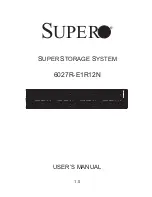
. . . . . . . . . . . . . . . . . . . . . . . . . . . . . .
1-15
Introduction to the ProLiant Storage System /U
Compaq ProLiant Storage System /U User Guide
Options
The following options are available for your ProLiant Storage System /U and
may be obtained from your local Compaq Reseller or Authorized Compaq
Service Provider.
Redundant Power Supply Option
ProLiant Storage System /U has provisions for adding a second power supply
that acts as a redundant supply when installed. The Redundant Power Supply is
identical to the primary supply and when installed, shares the electrical load
equally. If either supply should fail or be removed, the other will take over the
full load without interruption. Hot-pluggability permits replacing the failed
supply without bringing the system down.
The Redundant Power Supply can be installed by the user at any time by
simply plugging it in to the storage system. No tools are needed and there is no
need to bring the system down. See Chapter 5, “Installing Options” for more
information on installing and using this option.
Recovery Server Option
Recovery Server refers to a fault-tolerant technique where two independent
servers have access to the same stored data. Both servers are connected to
separate Wide-Ultra SCSI-3 ports on the storage system, but only one port has
access to the internal SCSI bus at a time. If the primary server should fail, the
Recovery Server option will automatically switch the storage system internal
SCSI bus connection to the secondary server. The secondary server will then
take over all functions of the system without loss of data. Both Online and
Backup recovery techniques are supported and all hardware, software,
instructions, and cabling are included in the kit. The Recovery Server Option
can only be used in ProLiant Storage System U1 (single bus) models.
The Recovery Server Option can be installed by the user by simply replacing
the standard I/O Board with the Recovery Server I/O Board. No tools are
required and there is no need to access internal cabling or circuitry. See
Chapter 5, “Installing Options” for more information on installing and using
this option.
















































